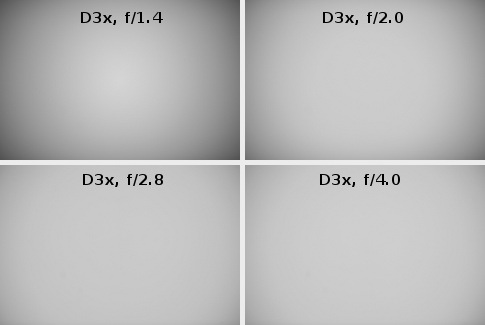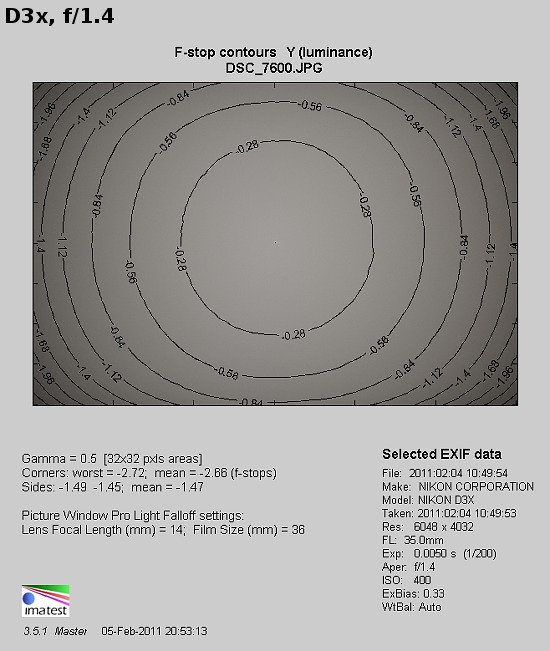Nikon Nikkor AF-S 35 mm f/1.4G
8. Vignetting

At the maximum relative aperture the brightness loss in the frame corners amounts to 32% (-1.12 EV). Such a value is clearly visible. Fortunately on stopping down the aperture to f/2.0 we see this problem being largely eliminated because the vignetting is 14% (-0.44 EV) there. The aberration disappears completely by f/2.8 where its level gets to only 5%.
Please Support UsIf you enjoy our reviews and articles, and you want us to continue our work please, support our website by donating through PayPal. The funds are going to be used for paying our editorial team, renting servers, and equipping our testing studio; only that way we will be able to continue providing you interesting content for free. |
- - - - - - - - - - - - - - - - - - - - - - - - - - - - - - - - - - - - - - - - - - - - - - - -
The chart below shows how the tested Nikkor compares with its 35 mm focal length rivals.
| |
Nikkor 1.4/35G |
Canon 1.4/35L |
Sony 1.4/35G |
Nikkor 2.0/35 |
| f/1.4 |
32% |
32% |
24% |
– |
| f/2.0 |
14% |
16% |
11% |
33% |
| f/2.8 |
5% |
8% |
4% |
16% |
Let’s describe now the full frame performance. The thumbnails of photos, taken on the Nikon D3x, are presented below.

The vignetting sticks out immediately. It would be difficult not to notice it if, at the maximum relative aperture, it reaches as much as 60% (-2.66 EV). The fans of magical vividness will be overjoyed. A shallow depth of field by f/1.4 combined with corners darker by almost 3 EV than the frame centre will certainly make the photos unusual vivid. Still the Nikkor can’t beat the Canon here because the Canon 1.4/35L had the light fall-off of over 3 EV. Speaking seriously it is the first testing category where the Nikkor beats the Canon distinctly.
Returning to our measurements we can say that the vignetting is still significant even by f/2.0 where it amounts to 44% (-1.69 EV). It can be also noticed by f/2.8 where it reaches 25% (-0.81 EV). It stops being a nuisance only by f/4.0 and f/5.6 where it is 15% and 11% respectively.
The chart below presents the comparison between the results of the Nikkor 1.4/35G on full frame and those of its rivals.
| |
Nikkor 1.4/35G |
Canon 1.4/35L |
Sony 1.4/35G |
Nikkor 2.0/35 |
| f/1.4 |
60% |
70% |
59% |
– |
| f/2.0 |
44% |
50% |
43% |
46% |
| f/2.8 |
25% |
35% |
23% |
30% |
| f/4.0 |
15% |
27% |
15% |
21% |
As you see the Nikkor and the Sony present a very similar level, being significantly better than the Canon. It is an interesting result because the Canon is physically the biggest lens here and the Sony – the smallest and exactly the smallest lens has the lowest vignetting.
 |






